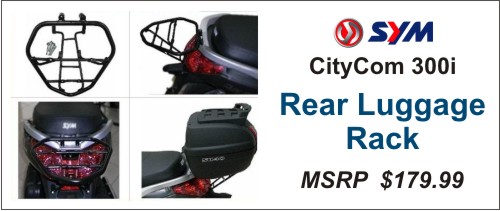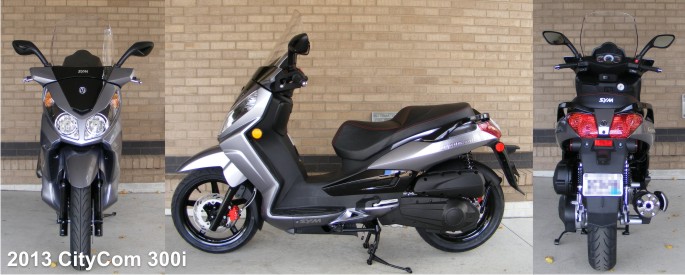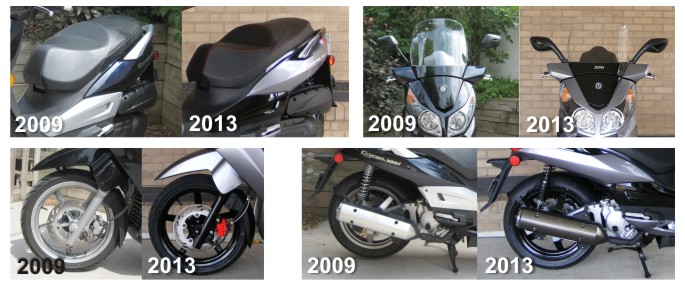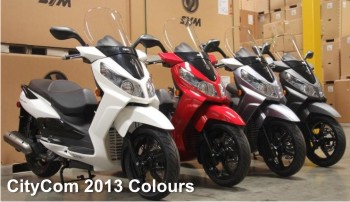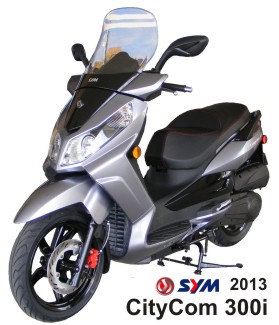

A proprietary rear luggage rack is available for the CityCom 300i.
TheCityCom 300i from SYM is back in the US market after a few years absence. SYM has a new US distributor and the mess of the Carter Brother’s situation is being slowly cleared away (click here for more info). I last reviewed the CityCom in July of 2009 and liked the scooter. Marty at Go Moto in Minneapolis just got a 2013 example in his shop and was kind enough to make it available to me for several days to check out.
Sanyang Industries is based in Taiwan and has been around since 1961. They have over 2,400 employees and are marketed in the USA as SYM (SanYang Motors). I have reviewed several of their scooters and have been impressed with their design and quality.
Those of you unfortunate enough to have suffered through my often ranting reviews know that I’m a HUGE fan of “do -everything” scooters. Machines that can handle city traffic and highway speeds in comfort with adequate cargo capacity, good fuel economy and good performance. In the past year, we have seen the arrival of the Kymco People GTi and the Piaggio BV 350. Now, with the return of the SYM CityCom, we have another excellent choice for those seeking one scooter to fill all their riding needs.
What’s Changed Since 2009 with the CITYCOM?
Well… that depends on which CityCom you are asking about. SYM has some newer engine designs in it’s 300-class scooters in other countries. I have heard 280cc as opposed to the current 263cc and more power. This is NOT what is being imported to the US… for now. When I asked about this, the very straightforward response was one of cost. The 2013 US-version CityCom has an MSRP of $4,699. Significantly less than the Kymco People GTi300 or the Piaggio BV350. The newer, more powerful drivetrain would raise the price considerably. There HAVE been upgrades to the seat, mirrors, brakes and exhaust.
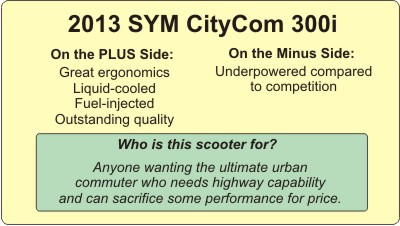
These are the questions, aside from “How much does it cost?”, that usually get asked first. Our scooter reviews include testing with GPS because most scooter speedometers are not very accurate. The vast majority of scooters have speedometers that read very optimistically – usually 10 – 15% optimistic. The 2013 CityCom is one of them, at about 11% optimistic. That means at an indicated 30 MPH, the GPS was indicating 27MPH,at 60 MPH indicated on the speedometer, the actual speed was 53 MPH. This is a little disappointing as the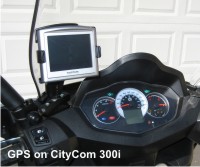
The top speed (GPS verified) with a 220 pound rider was 76MPH. The indicated speed was 85 MPH. The 2009 CityCom we tested did 79MPH, BUT, that scooter was broken in and this one was not. After some miles, I wouldn’t be surprised if the 2013 CityCom was also capable of faster speeds.
Fuel economy was outstanding at 68 MPG. This is 4 MPG better than the 2009 we tested. The riding was mixed with about 60% around town and 40% on the highway. Again, after break-in, this number may well improve. Evolution of engine design, manufacturing quality and the fuel injection makes these numbers possible. My “old” carbureted 250cc scooters had fuel economy in the 50ish MPG range. Nothing to sneeze at, but high 60s is a really great place to be with a scooter that is highway capable.
Features
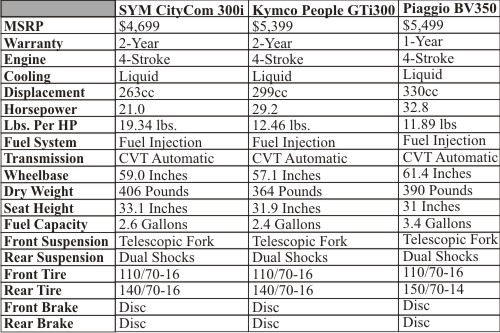

The updated mirrors on the 2013 CityCom look very nice and provide a decent field of view for what is going on behind one. The CityCom comes with a mid-sized windshield that is well integrated into the design of the scooter. There are also small “flairs” on the front body panel directly below the windshield that help to keep the windblast off one’s hands.
(Click) Did you hear that? The RANT switch just got turned on. One of my primary considerations in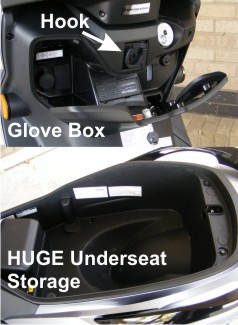

I contacted Alliance Powersports about the rear luggage rack and was assured that they are working on it and will have something here as soon as they can. There is a nice rear rack available overseas that would make it a snap to mount a trunk. With that addition, and the already excellent stock windshield, the SYM CityCom would have the best do-everything configuration of any scooter currently available in the USA. (Click) I’ve turned the RANT switch back to off.
The SYM CityCom has good lighting with dual 35-watt headlights and conventional signals and brake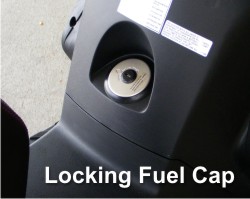
The CityCom functioned flawlessly during our review time. SYM’s reputation for quality is well deserved. All the switches, controls, latches, and so forth are of good quality and will probably prove to be quite durable over time. I know a few people who still have their 2009 CityCom scooters and they hold up well.
Riding Impressions

Turn the key, wait for the system to cycle, grab a brake lever and hit the starter button – the CityCom fires right up and settles into a smooth idle. Fuel injection rocks. Acceleration from a stop is smooth and quick. Not as quick as SYM’s own HD200 up to about 20 MPH, but the mid-range on the CityCom is very nice. This is one area that both the Kymco People GTi 300 and the Piaggio BV350 are much stronger than the CityCom. Go back up to that comparison chart and look at horsepower and, more importantly, pounds per horsepower. The CityCom is the heaviest of the three and the lowest in horsepower. It shows. The CityCom is also $700 less than GTi and $800 less than the BV.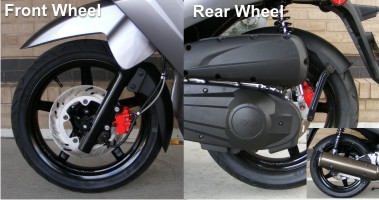
The last time I rode a CityCom (2009) the brakes were just adequate. The 2013 CityCom is definitely a step up from the older version in braking performance. I found the front and rear discs to be strong and easy to modulate. Probably because I was paying extra attention to the brakes, I did my panic stop tests several times and there was no fade or change in input required. Handling was very good and proved that one doesn’t have to compromise (much) to get a scooter that feels as good on 25 MPH parkways as it does on 65MPH highways. The combination of big wheels, relatively short wheelbase and upright steering geometry can feel just fine at a wide range of speeds. Of course the CityCom takes more effort on those twisty parkways than a Genuine Buddy with 10 inch wheels does. It also doesn’t have the “flowing” highway ride of a Burgman 650. HOWEVER neither of those scooters feels very good on the other end of the performance perspective. Yes, I have ridden a Buddy on the highway, on fairly long rides at fairly high speeds. Skittish is being 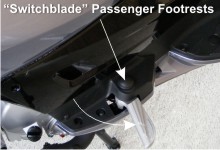
Passenger accommodations are quite nice on the CityCom. My wife Bev thought a backrest would be nice, but said the seat was very comfortable, the foot-pegs were at just the right position, and the grab-rail was handy. Of course adding a rear luggage rack and trunk with a backrest makes the passenger area about perfect.
I didn’t get any really long rides in during my time with this scooter, but I did manage a few jaunts on twisty roads without a lot of other traffic and the CityCom was fun. Something that can’t always be said of such a practical ride.
Fit and Finish
The 2009 CityCom was an impressive machine so far as build quality goes and the 2013 version is just as good if not a touch better. The 2013 version is available in white, red, grey and dark grey or what SYM calls flat black. It’s the grey version that I rode. The quality of the paint was excellent. Fit of the body panels is outstanding. Every component appears to be a high quality and very well put together. As I’ve said many times previously, good scooters out of Taiwan are as good as scooters from anyplace in the world. I know the flat black and grey are “safe” colors for dealers to stock, but I would like to see the red and white in person. Based on the quality I’ve seen, I’d not be surprised if they were just plain gorgeous.
The overall design of the CityCom really resonates with me. I know this is largely a question of personal taste, but the CityCom is one of the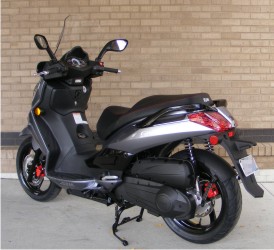
The quality of the 2009 CityCom was high and it certainly looks like the 2013 will continue at the same level.
Conclusions
For a conclusion, I’d like to jump back to the comparisons we’ve been making. If you are considering a do-everything scooter, answer a few question for yourself honestly. What is your real need? How much regular riding will be at city speeds? How much at highway speeds? What time of day? If you live in an area like Minneapolis, the highways are mostly 20 MPH with short bursts of 60 MPH during the rush hours. How about weekend trips? I know a fair number of people who will not consider the City Com as compared to the Kymco People GTi 300 and Piaggio BV350 just because of the power and top speed difference. I admit that I’m “hooked” on my own GTi 300 and make use of the scooter as a tourer for purely recreational purposes. I’ve also invested considerable time and resources in customizing my GTi and still don’t have a machine as comfortable as a CityCom. If you are really looking for a machine that will cover you in any commuting situation, city or highway, with comfort, reliability and efficient operation, look at a CityCom. Get the rear luggage rack, mount a SHAD 40 – 48 liter trunk, and enjoy many miles and years of use. All for hundreds less than the next closest choice. If you’ve just gotta have the extra horses, you probably haven’t read this far anyway.
David L. Harrington
UPDATE – A Proprietary Rear Luggage Rack is Available for the CityCom 300i
